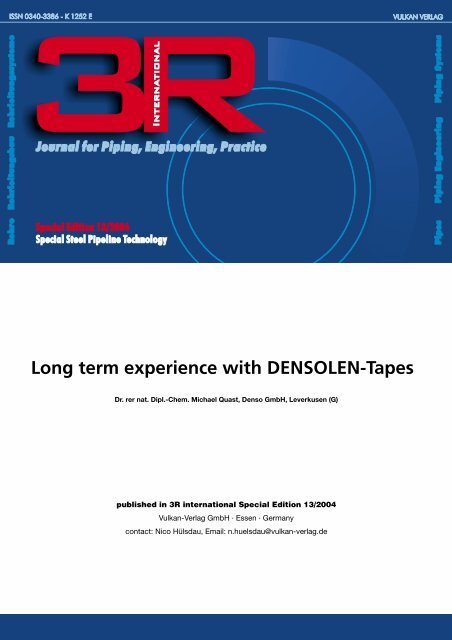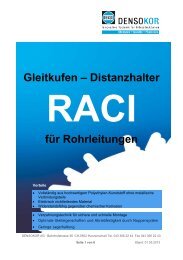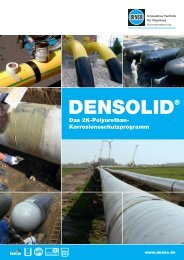Long term experience with DENSOLEN-Tapes
Long term experience with DENSOLEN-Tapes
Long term experience with DENSOLEN-Tapes
- No tags were found...
You also want an ePaper? Increase the reach of your titles
YUMPU automatically turns print PDFs into web optimized ePapers that Google loves.
<strong>Long</strong> <strong>term</strong> <strong>experience</strong> <strong>with</strong> <strong>DENSOLEN</strong>-<strong>Tapes</strong>Dr. rer nat. Dipl.-Chem. Michael Quast, Denso GmbH, Leverkusen (G)published in 3R international Special Edition 13/2004Vulkan-Verlag GmbH · Essen · Germanycontact: Nico Hülsdau, Email: n.huelsdau@vulkan-verlag.de
CORROSION PROTECTION<strong>Long</strong> <strong>term</strong> <strong>experience</strong> <strong>with</strong> <strong>DENSOLEN</strong>-<strong>Tapes</strong>Excavation of 27 year old pipelinesegments protected <strong>with</strong><strong>DENSOLEN</strong>-Tape S40Previous investigations on long <strong>term</strong>performance of polyethylene butylrubbercomposite tapes are based ontape samples, which as the longestperiod yet reported had been buried for17 years. Beside high insulationresistance values and extremely lowundermining corrosion [1] reports a veryhigh peel strength for <strong>DENSOLEN</strong>-TapeS40 after 17 years of operation. A currentpipeline project now offered theopportunity to confirm these results onlong <strong>term</strong> performance of <strong>DENSOLEN</strong>plastics tapes for an even longer ageingperiod.In autumn 2003 segments of a 27 yearold pipeline ("Isarschiene", running fromMoosburg (G) to Straubing (G)) owned byErdgas Südbayern (ESB) had to beexcavated for bypassing, which offeredthe opportunity for assessment ofthe coating performance (Figure 1 andFigure 2).The field joints of the polyethylenefactory coated pipeline had beenwrapped <strong>with</strong> four layers of <strong>DENSOLEN</strong>-Tape S40, which is a 0,75 mm thick,symmetrically structured three-ply tape<strong>with</strong> polyethylene carrier film andFig. 3: a) Cross Section of <strong>DENSOLEN</strong>-TapeS40, b) Cross section of <strong>DENSOLEN</strong> S40tape systemFig. 1: Dismounting location of pipe segmentsplies from butyl rubber on both sides(Figure 3). At the moment ofconstruction the four layer coatingsystem was in accordance <strong>with</strong> theDVGW-leaflet GW 7 [2], which was thevalid technical specification for fieldcoatings at that time. Although today'scorrosion protection standards [3], [4]and stress-classes had not yet beendeveloped in 1976, the <strong>DENSOLEN</strong> S40tape system would even fulfil today'srequirements of stress-class C-50.Correspondingly the observations madeon S40 can also be transferred tocurrently produced <strong>DENSOLEN</strong> tapes,which despite further developments andmodifications in the last 25 yearsare nevertheless comparable <strong>with</strong><strong>DENSOLEN</strong>-Tape S40 regarding generalfunction and composition. The mostimportant functional feature of suchthree-ply <strong>DENSOLEN</strong> tapes is their abilityto self amalgamate in the overlap areas,forming a sleeve type coating, which isimpermeable for water vapour andoxygen.Concerning operating conditions of the"Isarschiene" it has to be mentioned, thatstarting 1990 the cathodic protectionFig. 2:Dismounted pipesegments DN 300Dr. rer nat. Dipl.-Chem.Michael QuastDenso GmbH, Leverkusen (G)Tel. +49(0)214/2602-308Email: quast@denso.de3R international 43 (2004) Special Steel Pipeline Technology 69
CORROSION PROTECTIONFig. 4: Partly peeled off welded joint DN 300 <strong>with</strong> <strong>DENSOLEN</strong>-System S40Fig. 6: Close-up view of weld bead. Rust originates from outdoorstorage of pipe <strong>with</strong> partly peeled off tape wrappingsystem was run <strong>with</strong> partly severe cut-inpotentials of up to -15 V. In contrast up to1990 the cut-in potential showed typicalvalues of app. -2000 mV and the cut-offpotential typical values of app. -1100 mV.According to current information by thepipeline owner, the presently de<strong>term</strong>inedcut-in potentials range between -4 and-11 V. The dramatic change of theprotective potentials was caused byconstructive measures to avoidalternating current interference by tworailroad tracks running parallel to thepipeline. As a part of this constructivemeasures, two insulating couplings andseveral grounding units had beenincorporated into the pipeline, whichoriginally was built <strong>with</strong>out electricallyseparated segments [5]. A hydrogenembrittlement, which could have takenplace due to the very negative potentials,has not been observed [5]. Also apossible cathodic disbonding of the tapecoating could not be observed by thepresent investigation on the excavatedpipe segments.The outstanding long <strong>term</strong> behaviour of<strong>DENSOLEN</strong>-Tape S40 is now beingdemonstrated by peel strength testscarried out on the dismounted pipesegments, which is exemplarily shown inFigure 4 to Figure 7 exemplarily.Regarding the welded joint in Figure 4 ithas to be noticed that the adjacentfactory coating does not show any tracesof surface preparation and roughening.Therefore the tape could be peeled offfrom the smooth polyethylene surface<strong>with</strong>out any residues of adhesive, whichnevertheless required high peel strengthvalues of 13 to 16 N/cm at 10 mm/minpeel speed. According to commonprocedure in 1976 for pipe diameterssmaller than DN 500 [6], the transitionfrom steel to factory coating had notbeen bevelled. Consequently a 3 to4 mm wide hollow exists under the tapewrapping (Figure 5). Nevertheless, rustformation could not be observed. Suchhollows would be critical even in case ofcathodically protected pipes, if circulationof ground water was possible dueto incompletely sealed overlaps. Thus iscan be assumed, that the hollow hadbeen completely enclosed and sealed bythe tape wrapping.Similar to the behaviour on the factorycoating, the tape wrapping can bepeeled off <strong>with</strong>out residues of adhesive ina 5 to 7,5 cm wide area adjacent to thefactory coating. This effect is a result ofthe very smooth surface structure in thisarea, originating from either temporaryprotective coating or hotmelt adhesive,which had not been removed prior totape wrapping. In this area the steelsurface shows a slightly brown surface,nevertheless, undermining corrosion ormaterial loss could not be observed. Theobserved peel strength in this areacorresponds to the values obtained onthe factory coating.In the welding seam area (weld bead andadjacent 7,5 to 10 cm of steel surface)the tape could only be peeled off in acohesive peel mode <strong>with</strong> delamination inFig. 5: Hollow in transition to unbevelled factory coatingFig. 7: Dirt enclosed under tape wrapping703R international 43 (2004) Special Steel Pipeline Technology
CORROSION PROTECTIONFig. 9:Peel test <strong>with</strong>spring balance andtensile test deviceFig. 8: Delaminative (a) and cohesive (b) peelmode of tapes <strong>with</strong>out and <strong>with</strong> co-extrudedin<strong>term</strong>ediate layerssome parts. The obtained peel strengthranges between 25 and 38 N/cm at100 mm/min separation rate and 12 to15 N/cm at 10 mm/min. Also in the weldbead area no corrosion can be observed.Rust visible in Figure 6 originates fromoutdoor storage of the peeled off pipesegments. The reason for the partlydelaminative peel mode is the lackingof a co-extruded in<strong>term</strong>ediate layerbetween carrier film and butyl rubberadhesive. Such layers, a Densoinvention, significantly improve adhesionstrength between the tape plies andavoid delamination effects during peeltest (see Figure 8). Co-extruded layershave firstly been introduced into<strong>DENSOLEN</strong> tapes in 1981. Today theyare natural components of every<strong>DENSOLEN</strong> tape.ConclusionAlthough the surface preparation had notbeen carried out according to currentlyrecommended procedures, the<strong>DENSOLEN</strong>-Tape S40 does not showany decrease in coating performanceafter 27 years of operation. The observedand mentioned shortcomings in surfacepreparation should in any case beavoided. Nevertheless, the presentexample demonstrates the hightolerance of the cold applied <strong>DENSOLEN</strong>tape technology. The de<strong>term</strong>ined peelstrength values of <strong>DENSOLEN</strong>-Tape S40correspond to the performance of freshlyproduced material and are in accordance<strong>with</strong> today's standard requirements forstress-class C-50. No ageing effect canbe observed after 27 years of operation.Properties of <strong>DENSOLEN</strong>-TapeS40 after 25 years of storageCustomer re-sampling of tape rollsoffered the opportunity to test the tapeTable 1: Properties of <strong>DENSOLEN</strong>-Tape S40 and <strong>DENSOLEN</strong>-System S40-C (four layer tapewrapping) after 25 years of storage. Tests according to DIN EN 12068, stress-class C-50and system properties of <strong>DENSOLEN</strong>-Tape S40 after 25 years of storage. Testwere carried out on two 100 mm widetape rolls, one of which had been storedin-house, while the other had beenstored in an outdoor stockyard. Thede<strong>term</strong>ined material properties are listedin Table 1.All measured values significantly exceedthe standard requirements and correspondto the performance level of newmaterial. Even after 25 years of storagethe stress-class C-50 requirements ofDIN EN 12068 and DIN 30672 are fulfilled<strong>with</strong>out any difficulties. Ageing effectscan not be observed.References[1] Schwenk, W.; Heim, G.; Wedekind, B.;Schäfer, T.: Untersuchungen der Korrosionsschutzwirkungvon Umhüllungen ausStahlleitungsrohren nach langzeitigerAuslagerung in Wasser und im Erdboden.3R internat. 35 (1996), Nr. 12, S. 676-685[2] DVGW-Arbeitsblatt GW 7 „Korrosionsschutzbindenfür erdverlegte Rohrleitungenund unterirdische Behälter - Anforderungenund Prüfverfahren“ (1969-11)[3] DIN EN 12068 „Kathodischer Korrosionsschutz- Organische Umhüllungen für denKorrosionsschutz von in Böden undWässern verlegten Stahlrohrleitungen imZusammenwirken mit kathodischem Korrosionsschutz- Bänder und schrumpfendeMaterialien" (1999-03)[4] DIN 30672 „Organische Umhüllungen fürden Korrosionsschutz von in Böden undWässern verlegten Rohrleitungen fürDauerbetriebstemperaturen bis 50 °Cohne kathodischen Korrosionsschutz -Bänder und schrumpfende Materialien“(2000-12)[5] Peez, G. in 3R internat. 43 (2004) Nr. 7, S.400 - 408[6] Leinweber, E.: Praktische Erfahrungen mitRohrumhüllungen nach DIN 30672. 3Rinternat. (1977), Nr. 6, S. 331 - 3343R international 43 (2004) Special Steel Pipeline Technology 71
















